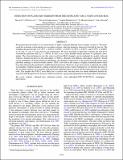Detection of Planetary Emission from the Exoplanet Tres-2 Using Spitzer/IRAC
Author(s)
O’Donovan, Francis T.; Charbonneau, David; Madhusudhan, Nikku; Seager, Sara; Harrington, Joseph, III
DownloadSeager_Detection of planetary.pdf (323.0Kb)
PUBLISHER_POLICY
Publisher Policy
Article is made available in accordance with the publisher's policy and may be subject to US copyright law. Please refer to the publisher's site for terms of use.
Terms of use
Metadata
Show full item recordAbstract
We present here the results of our observations of TrES-2 using the Infrared Array Camera on Spitzer. We monitored this transiting system during two secondary eclipses, when the planetary emission is blocked by the star. The resulting decrease in flux is 0.127% ± 0.021%, 0.230% ± 0.024%, 0.199% ± 0.054%, and 0.359% ± 0.060% at 3.6 μm, 4.5 μm, 5.8 μm, and 8.0 μm, respectively. We show that three of these flux contrasts are well fit by a blackbody spectrum with T [subscript eff] = 1500 K, as well as by a more detailed model spectrum of a planetary atmosphere. The observed planet-to-star flux ratios in all four IRAC channels can be explained by models with and without a thermal inversion in the atmosphere of TrES-2, although with different atmospheric chemistry. Based on the assumption of thermochemical equilibrium, the chemical composition of the inversion model seems more plausible, making it a more favorable scenario. TrES-2 also falls in the category of highly irradiated planets which have been theoretically predicted to exhibit thermal inversions. However, more observations at infrared and visible wavelengths would be needed to confirm a thermal inversion in this system. Furthermore, we find that the times of the secondary eclipses are consistent with previously published times of transit and the expectation from a circular orbit. This implies that TrES-2 most likely has a circular orbit, and thus does not obtain additional thermal energy from tidal dissipation of a non-zero orbital eccentricity, a proposed explanation for the large radius of this planet.
Date issued
2010-02Department
Massachusetts Institute of Technology. Department of Earth, Atmospheric, and Planetary Sciences; Massachusetts Institute of Technology. Department of PhysicsJournal
Astrophysical Journal
Publisher
IOP Publishing
Citation
O’Donovan, Francis T. et al. “Detection of Planetary Emission from the Exoplanet Tres-2 Using Spitzer/IRAC.” The Astrophysical Journal 710.2 (2010): 1551–1556. © 2010 IOP Publishing
Version: Final published version
ISSN
0004-637X
1538-4357